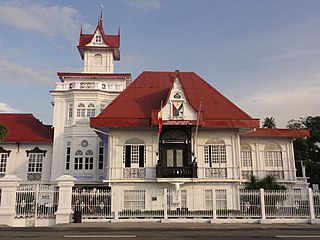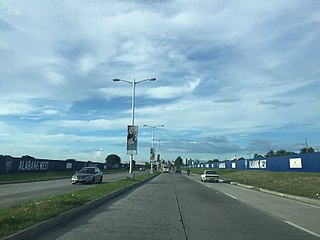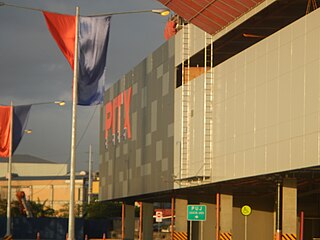
Cavite, officially the Province of Cavite, is a province in the Philippines located in the Calabarzon region in Luzon. Located on the southern shores of Manila Bay and southwest of Metro Manila, it is one of the most industrialized and fastest-growing provinces in the Philippines. Its population of 3,678,301 (2015) makes it one of the most populated provinces in the country. Originally agricultural and now a booming bedroom community for ultracongested Metro Manila, its location just north of Taal volcano poses significant risks of ashfall, and debris flows through it into Manila Bay.

The South Luzon Expressway, formerly known as the South Superhighway (SSH), the Manila South Diversion Road (MSDR), and the Manila South Expressway (MSEX), is a network of two expressways that connects Metro Manila to the provinces of the Calabarzon region on the island of Luzon in the Philippines. The first expressway is a part of Skyway At-Grade, operated jointly by the Skyway Operations and Management Corporation (SOMCO) and SMC Skyway Corporation, running from Makati to Alabang, Muntinlupa. The second expressway, the South Luzon Tollway (SLT) or Alabang–Calamba–Santo Tomas Expressway (ACTEX), is jointly operated by the SMC SLEX, Inc., a joint venture of the Philippine National Construction Corporation and the San Miguel Corporation-backed PT Citra Marga Nusaphala Persada Tbk group of Indonesia via the Manila Toll Expressway Systems, Inc. (MATES), running from Alabang, Muntinlupa to Santo Tomas, Batangas.

Rail transportation in the Philippines is currently used mostly to transport passengers within Metro Manila and the nearby province of Laguna, as well as a commuter service in the Bicol Region. Freight transport services once operated in the country, but these services were halted. However, there are plans to restore old freight services and build new lines.

The Manila–Cavite Expressway, also known as Coastal Road, CAVITEX and R-1 Expressway, is a 14-kilometer-long (8.7 mi) limited-access toll expressway linking Manila to the southern province of Cavite in the Philippines. The entire expressway is designated as Expressway 3 (E3) of the Philippine expressway network and forms part of Radial Road 1 (R-1) of Manila's arterial road network. It is owned and maintained by the Public Estates Authority Tollway Corporation (PEATC), a government corporation and subsidiary of the Public Estates Authority, a government agency under the Office of the President, and is operated by Cavite Infrastructure Corporation, a unit of Philippine-based company Metro Pacific Investments Corporation (MPIC).

EDSA station is a station on the Manila Light Rail Transit System Line 1. Like all other stations in the system, EDSA station is above-ground. The station is located on the intersection of Taft Avenue and Epifanio de los Santos Avenue, or EDSA, one of Metro Manila's main thoroughfares. The station was named after EDSA, which in turn is named after Epifanio de los Santos, a noted historian.

Baclaran station is a station on the Manila Light Rail Transit System Line 1. The station is located on the last stretches of Taft Avenue in Pasay right at the border with Baclaran, Parañaque, and like all other stations on the Line 1, Baclaran terminal is above-ground on viaduct. The terminal is named after the famous shopping district of the same name, which is located on the borders of the cities of Pasay and Parañaque.

The Light Rail Transit Line 1 commonly referred to as LRT Line 1 or LRT-1 is a light rapid transit system line in Metro Manila, Philippines, operated by Light Rail Manila Corporation (LRMC) and owned by the Light Rail Transit Authority (LRTA) as part of the Manila Light Rail Transit System. Currently, the line consists of 20 stations and runs on 19.65 kilometers (12.21 mi) of fully elevated route.

Taft Avenue station is a station on the Manila Metro Rail Transit System Line 3, and is the line's only station in Pasay. The station is located at the corner of Epifanio de los Santos Avenue, or EDSA, one of Metro Manila's main thoroughfares, and Taft Avenue. The station is named after Taft Avenue, which is named after former U.S. President and U.S. Chief Justice William Howard Taft, who served as Governor-General of the Philippines from 1901 to 1903.
Zapote station is an under construction at-grade station on the Manila Light Rail Transit System Line 1. It is part of the Line 1 South Extension Project. The station would be the first Line 1 station outside Metro Manila being located in Bacoor in Cavite. The station will be located near the Zapote Exit Ramp of Manila-Cavite Expressway in Barangay Zapote V (Longos) in Bacoor.

Radial Road 2 (R-2), informally known as the R-2 Road, is a network of roads and bridges that all together form the second arterial road of Metro Manila in the Philippines. Spanning some 64.2 kilometers (39.9 mi), it connects the cities and municipalities of Bacoor, Dasmariñas, Imus, Las Piñas, Manila, Parañaque, Pasay, Silang, and Tagaytay in Cavite and Metro Manila.
Niog station is a station under construction on the Manila Light Rail Transit System Line 1 and a proposed station on Line 6. The station will be located on Bacoor Boulevard, about 200 metres away from the intersection with Aguinaldo Highway in Bacoor in Cavite. The closest immediate landmarks to the station are the newly built Hotel Sogo branch which would be right next to the station plot, McDonald's, and St. Dominic Medical Center further down on the corner with Aguinaldo Highway. It is part of the Line 1 South Extension Project, being the final station on the planned extension, while it shall be an intermodal terminal with the Line 6 towards Governor's Drive station.

Dr. Arcadio Santos Avenue or Dr. Santos Avenue, formerly and still referred to as Sucat Road or Parañaque–Sucat Road, is the primary east–west thoroughfare in Parañaque, southern Metro Manila, Philippines. The avenue's western end is in Barangay San Dionisio as the continuation of Ninoy Aquino Avenue. Physically, Ninoy Aquino Avenue connects northbound to NAIA Road in Pasay which, in turn, continues west to Roxas Boulevard back in Parañaque, where it ends. Its eastern end is at the East Service Road, which runs parallel to South Luzon Expressway, in Barangay Sucat, Muntinlupa, where it becomes Meralco Road to service the rest of the route to Sucat railway station.

Alabang–Zapote Road is a four-lane national road which travels east–west through the southern limits of Metro Manila, Philippines. It runs parallel to Dr. Santos Avenue in the north and is named for the two barangays that it links: Alabang in Muntinlupa and Zapote in Las Piñas.

Daang Hari, also known as the Las Piñas–Muntinlupa–Laguna–Cavite Link Road, is a collector road that links southern Metro Manila to the province of Cavite in the Philippines. It begins as a north–south road from Commerce Avenue, just south of the Alabang–Zapote Road running for 5.9 kilometers (3.7 mi) on the boundary of Las Piñas and Muntinlupa. It then runs east–west for about 9.2 kilometers (5.7 mi) from its junction with Daang Reyna, winding through the cities of Bacoor, Imus, Dasmariñas, and General Trias.

The PNR Metro Commuter Line is a commuter rail line operated by the Philippine National Railways. It was first inaugurated as the Metro Manila Commuter Service in 1970, and originally served the North Main Line and the South Main Lines, as well as the defunct Carmona and Guadalupe branch lines. Since then, it adopted several names such as Metrotrak and Metrotren, before adopting its present name in the late 2000s. The line is also nicknamed the Orange Line due to its designation in the 1970s.

The following is an alphabetical list of articles related to the Philippine capital region of Metro Manila.

The Parañaque Integrated Terminal Exchange (PITx), formerly called Southwest Integrated Transport System (SWITS), is a public transport terminal in Parañaque, Metro Manila, Philippines. PITx is built and operated by Megawide Construction Corporation and the Department of Transportation (DOTr) under the Philippine government's Public-Private Partnership program.

San Dionisio is an administrative division in southern Metro Manila, Philippines. It is a barangay at the southwestern edge of Parañaque and north of its border with Manuyo, Las Piñas. The barangay is centered on the westernmost section of Dr. Santos Avenue where it veers north and parallels Elpidio Quirino Avenue with De Leon Street and Aldana Avenue forming its boundaries with La Huerta and Manuyo Uno respectively. It extends to the east along the San Dionisio River-Villanueva Creek by barangay Moonwalk to the north and along Balong Creek by Manuyo Dos, Las Piñas to the south towards its border with San Isidro. San Dionisio includes a large swath of the C-5 Road South Extension properties in Parañaque including the Amvel Business Park, Avida Sucat and SM City Sucat sites, the Irasan Complex logistics hub, and as well as the area surrounding the Evacom Plaza. It also covers a significant portion of the reclaimed Freedom and Long Islands in the Las Piñas–Parañaque Critical Habitat and Ecotourism Area.
Ninoy Aquino station is a station under construction on the Manila Light Rail Transit System Line 1. It is part of the Line 1 South Extension Project. The station would be built in Ninoy Aquino Avenue in La Huerta, Parañaque.















